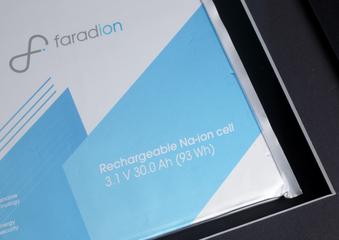
Small Polymer Solar Cell with Carbon Contacts




Small polymer solar cell with carbon contacts, by DTU National Laboratory for Sustainable Energy, University of Denmark, Roskilde, Denmark, 2014.
The cost of solar technology has fallen beyond all expectations in recent years, yet silicon, the element most photovoltaic cells are still based on, is expensive. The high cost of pure silicon is a consideration and arguably a limiting factor to more widespread use of solar power. Scientists such as Professors Jenny Nelson and Frederik Krebs at the Technical University of Denmark (DTU) believe that solar cells made instead from polymers, the main component of plastics, are the key to making solar-cell technology much more widely accessible, especially in developing countries.
This plastic solar cell, coming out of DTU’s National Laboratory for Sustainable Energy, uses much cheaper basic materials compared to the pure silicon wafers that are used conventionally, and the production process is also low cost. The flexibility and low cost of plastic solar cells make them suitable for a wider range of uses, for instance as mobile chargers that can be integrated into textiles. However, their efficiency and durability are not as high as some other solar cells, so this type of cell represents one part of the mix of solutions to harnessing renewable solar power in a range of different contexts. It has been displayed in the Atmosphere gallery since 2014, sitting alongside other solar cell technologies, and would make a valuable addition to our growing collection of renewable technologies.
At the heart of the solar cell there is a thin layer, which contains two different materials blended together. This thin layer is where the conversion of light energy into electrical energy occurs. The two components of this inner layer are a polymer – a plastic component – and a molecule called a fullerene. Both materials are able to absorb light and conduct electrical charge. The fullerene attracts electrons, negative electrical charges, while the polymer attracts positive charges.
When light from the Sun hits the solar cell, electrons are released from the polymer into the fullerene. These freed charges create a flow of electricity, collected by electric contacts on both sides of the cell, which can be used to power devices.
The cells were made by printing layers of polymers and electric contact materials onto a roll of plastic. In the printing process, inks containing the different materials are printed successively onto a long plastic sheet in a roll-to-roll process similar to newspaper printing.
This solar cell was cheap and easy to produce, but has only a limited efficiency – between 2 and 3%. This is low, especially compared to other alternatives to silicon, such as perovskites, whose efficiency can be as high as around 30%, but the reduced energy cost of making, installing and running these cells is what makes them special. A lower efficiency in operation can be balanced against the low cost and energy used in making the cells work.
However, the possible applications of this technology are very attractive. They could be used on bags or clothes to power small electrical devices such as radios or to charge mobile phone batteries. They could also be used in developing countries, providing access to a cheap, renewable and low-carbon source of energy.
Details
- Category:
- Electricity Supply
- Object Number:
- 2022-1050
- Materials:
- electronic components, plastic (unidentified), polyethylene terephthalate, conductive polymers, semi-conductive polymers, zinc oxide and adhesive
- Measurements:
-
overall: 1 mm x 140 mm x 100 mm,
- type:
- solar cell
- credit:
- Frederk C. Krebs, Technical University of Denmark Department of Energy Conversion and Storage, Solar Energy Frederiksborgvej 399 4000 Roskilde Denmark




